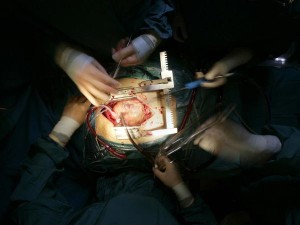
Are the terms intern, resident, and attending surgeon confusing? For a glimpse of how surgeons are trained in this country, read on.
Me: Your stories are populated with medical students, interns, surgery residents and attending surgeons. Can you explain the various designations?
Myself: Medical education is built upon increasing responsibility and experience. Medical students are, of course, students. You earn a bachelor’s degree, apply to med school, get accepted, pay a small fortune, and when you’re finished they call you Doctor, but you’re not really a doctor. M.D.’s become doctors during their residency. A residency is an apprenticeship in a chosen specialty, which for general surgery spans five years. Interns (first-year residents) and junior residents (years 2 and 3) are supervised by senior residents (years 4 and 5). Fifth-year residents, who are supervised by attending surgeons, are called chief residents because they run the services to which they are assigned. A surgery service is based upon the types of procedures performed and may include general surgery, transplant surgery, cardiothoracic, pediatric, and trauma surgery (among others). Surgical attendings (fully-trained, board-certified surgeons) staff the surgical services and are responsible for the teaching and supervision of the residents who rotate on their services.
Me: Sounds like a long haul. Four years of college. Four years of medical school. Five years of residency. That’s thirteen years of higher education.
Myself: Even longer if you want to sub-specialize. In total I did four years of college, four years of med school, five years of general surgery, two years of research at the NIH (to increase my chances of landing a prestigious cardiothoracic residency), two years of cardiothoracic surgery (at NYU, very prestigious) and an additional year of cardiothoracic research, for a total of eighteen years. I finally entered practice at age 36, which meant I had spent half my life pursuing higher education.
Me: That explains the young kids and the bad back.
Myself: Yes. Career before family.
Me: Can you give me an example of how the residency-training hierarchy works?
Myself: I can. An uncomplicated appendectomy might be performed by an intern under the supervision of a third-year resident. A cholecystectomy (removal of the gallbladder) is generally a third-year case with a fourth- or fifth-year resident as teaching surgeon. A hemi-gastrectomy (removal of half the stomach) is a chief-resident case with an attending surgeon supervising. If a case becomes complicated—the appendix is ruptured and the abdomen is full of pus, or gallstones have migrated from the gallbladder into the common bile duct—the chief resident (in the case of the appendectomy) or the attending surgeon (in the case of the cholecystectomy) may “scrub in” and offer their experience and expertise.
Me: In your short story The Final Push, you have a third-year medical student working up a trauma patient under the supervision of a chief resident.
Myself: The medical student is doing a two-month trauma rotation and is on call for the trauma team when a critically-injured man is brought into the emergency room. The intern and third-year resident are in the operating room patching a perforated gastric ulcer, so the chief resident allows the student to do things that a resident would normally do. Obviously, this is a great learning experience for the medical student.
Me: You did your medical school and residency training back in the eighties and nineties. With today’s medico-legal climate, do you think students and residents still have this kind of autonomy?
Myself: I don’t know, and it would be a shame if they don’t, but in my story world they do.
To read the interview in its entirety, go here .
